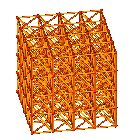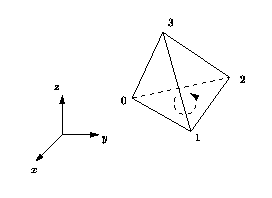

The basic 3D-triangulation class of CGAL is primarily designed to represent the triangulations of a set of points in . It can be viewed as a partition of the convex hull of into tetrahedra whose vertices are the points of . Together with the unbounded cell having the convex hull boundary as its frontier, the triangulation forms a partition of .
In order to deal only with tetrahedra, which is convenient for many applications, the unbounded cell can be subdivided into tetrahedra by considering that each convex hull facet is incident to an infinite cell having as fourth vertex an auxiliary vertex called the infinite vertex. In that way, each facet is incident to exactly two cells and special cases at the boundary of the convex hull are simple to deal with.
The class Triangulation_3<Traits,Tds> of CGAL implements this point of view and therefore considers the triangulation of the set of points as a set of finite and infinite tetrahedra. Notice that the infinite vertex has no significant coordinates and that no geometric predicate can be applied on it.
A triangulation is a collection of vertices and cells that are linked together through incidence and adjacency relations. Each cell gives access to its four incident vertices and to its four adjacent cells. Each vertex gives access to one of its incident cells.
The four vertices of a cell are indexed with 0, 1, 2 and 3 in positive
orientation, the positive orientation being defined by the orientation
of the underlying Euclidean space . The neighbors of a cell are also
indexed with 0, 1, 2, 3 in such a way that the neighbor indexed by
is opposite to the vertex with the same index. See
Figure ![]() .
.
Figure: Orientation of a cell (3-dimensional case)

As in the underlying combinatorial triangulation (see
Chapter ![]() ), edges (-faces) and facets (-faces)
are not explicitly
represented: a facet is given by a cell and an index (the facet
i of a cell c is the facet of c that is opposite to
the vertex with index i) and an edge is given by a cell and two
indices (the edge (i,j) of a cell c is the edge whose
endpoints are the vertices of c with indices i and
j). See Figure
), edges (-faces) and facets (-faces)
are not explicitly
represented: a facet is given by a cell and an index (the facet
i of a cell c is the facet of c that is opposite to
the vertex with index i) and an edge is given by a cell and two
indices (the edge (i,j) of a cell c is the edge whose
endpoints are the vertices of c with indices i and
j). See Figure ![]() .
.
The class Triangulation_3<Traits,Tds> can also deal with triangulations whose dimension is less than 3. A triangulation of a set of points in covers the whole space and consists of cells having vertices: some of them are infinite, they are obtained by linking the additional infinite vertex to each facet of the convex hull of the points.
The same cell class is used in all cases: triangular faces in 2D can be considered as degenerate cells, having only three vertices (resp. neighbors) numbered , and one vertex (resp. neighbor); edges in 1D have only two vertices (resp. neighbors) numbered and .
The implicit representation of facets (resp. edges) still holds for degenerate dimensions (i.e.dimensions ) : in dimension 2, each cell has only one facet of index 3, and 3 edges , and ; in dimension 1, each cell has one edge .
A triangulation of is said to be locally valid iff
(a)-(b) Its underlying combinatorial graph, the triangulation
data structure, is locally valid
(see Section ![]() of Chapter
of Chapter ![]() )
)
(c) Any cell has its vertices ordered according to positive
orientation. See Figure ![]() .
.
When the triangulation is degenerated into a triangulation of dimension 2, the geometric validity reduces to:
(c-2D) For any two adjacent triangles and with common edge , and lie on opposite sides of in the plane.
When all the points are collinear, this condition becomes:
(c-1D) For any two adjacent edges and , and lie on opposite sides of the common vertex on the line.
The is_valid() method provided by CGAL checks the local validity of a given triangulation. This does not always ensure global validity [MNS96, DLanRT98] but it is sufficient for practical cases.
The class Triangulation_3<Traits,Tds> is designed to be used as
a layer upon a 3D-triangulation data structure as presented in
Section ![]() of Chapter
of Chapter ![]() .
It provides high level geometric operations such as location of a point
in the triangulation and insertion of a point, and is responsible for
the geometric validity. This class is parameterized by two classes:
.
It provides high level geometric operations such as location of a point
in the triangulation and insertion of a point, and is responsible for
the geometric validity. This class is parameterized by two classes:
Delaunay triangulations as well as hierarchical Delaunay triangulations [Dev98] are also implemented in the package: Delaunay_triangulation_3<Traits,Tds> inherits from Triangulation_3<Traits,Tds> and Delaunay_hierarchic_triangulation_3<Traits,Tds> inherits from Delaunay_triangulation_3<Traits,Tds>. (Hierarchical Delaunay triangulations are not yet implemented.)
Triangulation_3<Traits,Tds> derives from
Triangulation_utils_3<Traits,Tds>, which defines a set of tools
working on the indices of vertices in cells (see
Section ![]() ).
).
#include <CGAL/basic.h>
#include <iostream>
#include <list>
#include <vector>
#include <CGAL/Cartesian.h>
#include <CGAL/Triangulation_cell_base_3.h>
#include <CGAL/Triangulation_vertex_base_3.h>
#include <CGAL/Triangulation_data_structure_3.h>
#include <CGAL/Triangulation_geom_traits_3.h>
#include <CGAL/Triangulation_3.h>
typedef CGAL::Cartesian<double> Rep;
typedef CGAL::Triangulation_geom_traits_3<Rep> Gt;
typedef CGAL::Triangulation_vertex_base_3<Gt> Vb;
typedef CGAL::Triangulation_cell_base_3<Gt> Cb;
typedef CGAL::Triangulation_data_structure_3<Vb,Cb> TDS;
typedef CGAL::Triangulation_3<Gt,TDS> Triangulation;
typedef typename Triangulation::Cell_handle Cell_handle;
typedef typename Triangulation::Vertex_handle Vertex_handle;
typedef typename Triangulation::Locate_type Locate_type;
typedef Gt::Point Point;
int main(int argc, char* argv[])
{
Triangulation T;
// insertion from a list :
std::list<Point> L;
L.push_front(Point(0,0,0));
L.push_front(Point(1,0,0));
L.push_front(Point(0,1,0));
int n = T.insert(L.begin(), L.end());
// insertion from a vector :
std::vector<Point> V(3);
V[0] = Point(0,0,1);
V[1] = Point(1,1,1);
V[2] = Point(2,2,2);
n = n + T.insert(V.begin(), V.end());
// 6 points have been inserted :
assert( n == 6 );
// checking validity of T :
assert( T.is_valid(false) );
Locate_type lt;
int li, lj;
Point p(0,0,0);
Cell_handle c = T.locate(p, lt, li, lj);
// p is the vertex of c of index li :
assert( lt == Triangulation::VERTEX );
assert( c->vertex(li)->point() == p );
Vertex_handle v = c->vertex( (li+1)&3 );
// v is another vertex of c
Cell_handle nc = c->neighbor(li);
// nc = neighbor of c opposite to the vertex associated with p
// nc must have vertex v :
int nli;
assert( nc->has_vertex( v, nli ) );
// nli is the index of v in nc
std::ofstream oFileT("output",ios::out);
// writing file output;
oFileT << T;
return 0;
}
(See [Dev98].)
The first template parameter of the triangulation class Triangulation_3<Traits,Tds> of CGAL is the geometric traits class.
The first subsection of this section describes the requirements that a geometric traits class must fulfill. The second subsection presents a predefined geometric traits class available in CGAL.
The weighted point class must fulfill the following requirements:
|
| |
|
The point type
| |
|
| |
|
The weight type
| |
|
|
| The ring type |
|
|
|
|
|
|
|
|
|
|
The second template parameter of the basic triangulation class Triangulation_3<Traits,Tds> is a triangulation data structure class. This class can be seen as a container for the cells and vertices maintaining incidence and adjacency relations.
The concept for the triangulation data structure is described in
Section ![]() of Chapter
of Chapter ![]() . Its optional
arguments related to geometry are compulsory for this use as a
template parameter of Triangulation_3<Traits,Tds>.
A model of this triangulation data structure is
Triangulation_data_structure_3 presented in
Section
. Its optional
arguments related to geometry are compulsory for this use as a
template parameter of Triangulation_3<Traits,Tds>.
A model of this triangulation data structure is
Triangulation_data_structure_3 presented in
Section ![]() .
.